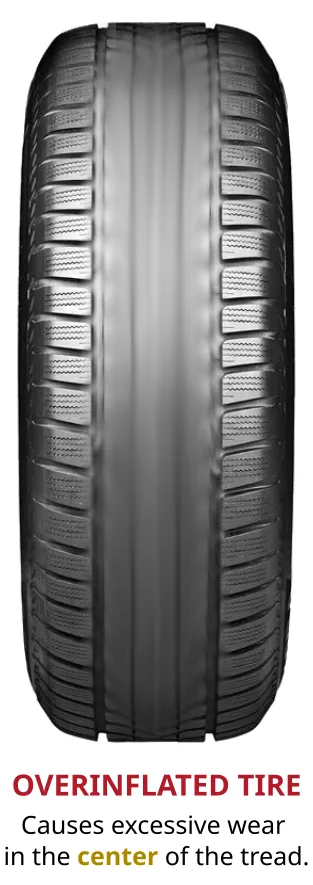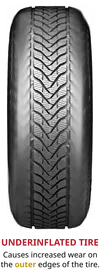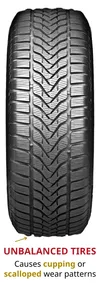Tires are an essential component of any vehicle, responsible for providing traction, handling, and a smooth ride. However, over time, tires can develop irregular wear patterns, which can compromise their performance and safety.
In this article, we will help you understand the causes and symptoms of irregular tire wear patterns. You will learn how to ensure your vehicle's optimal performance and extend the lifespan of your tires.
Table of Contents
- What is Irregular Tire Wear?
- How to Spot Irregular Wear
- Common Causes
- Improper Inflation (Over-Inflation or Under-Inflation)
- Wheel Misalignment
- Unbalanced Tires
- Suspension Problems
- Aggressive Driving Habits
- Types of Irregular Wear Patterns
- Center Wear
- Shoulder/Edge Wear
- Cupping/Scalloping
- Flat Spots
- Feathering
- One-Sided Wear (Camber)
- Addressing Irregular Wear
- Conclusion
What is Irregular Tire Wear?
Irregular tire wear is the wearing out of tires in an uneven manner on the tread surface. This is different from the normal even wearing of treads over a long period as a result of constant use. It can be helpful to detect irregular wear patterns early enough so as to prevent premature replacement and address underlying problems leading to uneven wear.
How to Spot Irregular Wear
To find if there is irregular tire wear, it’s necessary that regular visual checks are carried out on the tread across all tires. Watch for signs of uneven wear like balding spots, scalloped edges or one side of the tire being worn out faster than the other. Besides, feel with your hand any differences or alterations in groove depths while going through across treads.
It is also important to check tread depth. Most tires have small bars or markings called tread wear indicators located within their tread grooves. Once you get to these marks it’s time to replace them.
| Tread Depth | Tire Condition |
|---|---|
| 8/32" (6.35mm) or greater | Excellent |
| 6/32" (4.76mm) | Still good, but starting to wear |
| 4/32" (3.17mm) | Worn, should be replaced soon |
| 2/32" (0.06mm) or less | Dangerous and must be replaced immediately |
Regularly checking your tires and observing the depth of their treads can help you detect any early signs of irregular wear as well as take steps to solve this problem.
Common Causes
There are several factors that contribute to wear patterns on the tire, some are small maintenance problems while others are complex mechanical issues. Knowing why they happen can help you avoid or deal with them properly.
Improper Inflation (Over-Inflation or Under-Inflation)
Maintaining proper tire pressure is crucial for even tread wear and optimal performance. Over-inflation may cause excessive wear in the center of the tire, where there is a smaller area of contact between the tire and road.
When underinflated, tires tend to wear out at their outer edges (shoulders) of the tire only as the contact patch becomes larger and the weight distribution shifts towards the edges.
Wheel Misalignment
Misaligned wheels change the way tires go round, leading to uneven tires wears like feathering or one sided wears.
The tread blocks develop a rounded edge on one side and sharp edge on other sides indicating toe alignment problem which is referred to as feathering.
One-sided wear otherwise known as camber wear shows that either inner or outer ribs have excessive tear signifying camber misalignment.
Unbalanced Tires
When a tire is not properly balanced, it causes uneven weight distribution making the tire to hop or bounce while rotating. The bouncing that happens leads to creation of cupped or scalloped patterns in the thread thus accelerating wear and compromising ride quality.
Suspension Problems
Also worn or damaged suspension parts such as shocks, struts and control arms may result in irregular tire wear patterns. For instance, worn out shocks or struts cause cupping or scalping because they cannot effectively check motion of tires. At the same time, there can be suspension damage causing misalignment leading to one-sided wear or feathering.
Aggressive Driving Habits
Fast braking, hard cornering or any other form of aggressive driving will increase irregular tire wear. Braking hard results in flat spots on the tread whereas aggressive cornering leads to more wear on outer shoulder of tyres. Additionally, high speed driving emits great heat that breaks down compound thereby increasing treadwear rate.
Types of Irregular Wear Patterns
Different types of irregular tire wear indicate specific underlying issues. Understanding these patterns can help you identify the root cause and take appropriate corrective actions.
Center Wear

Center wear is characterized by excessive wear in the center of the tread, while the outer edges remain relatively unaffected. This pattern is typically caused by over-inflation, which reduces the tire's contact patch and concentrates the weight on the center portion of the tread. Center wear can lead to reduced tread contact, decreased handling, and increased risk of hydroplaning.
Shoulder/Edge Wear

Shoulder or edge wear occurs when the outer edges of the tire tread wear down more quickly than the center. This pattern is often caused by under-inflation, which increases the contact patch and shifts the weight distribution towards the outer edges of the tire. Shoulder/edge wear can result in increased fuel consumption due to increased rolling resistance and reduced traction, especially in wet or icy conditions.
Cupping/Scalloping

Cupping or scalloping refers to the formation of cup-like or scalloped patterns around the tread's circumference. This pattern is typically caused by worn or damaged suspension components, such as shocks or struts, which fail to control the tire's bouncing motion effectively. Cupping/scalloping can lead to a rough, uncomfortable ride and accelerated tire wear.
Flat Spots
Flat spots are smooth, bald areas on the tire tread, often caused by hard braking or skidding. These flat spots can compromise the tire's traction and handling and may require tire repair or replacement, depending on the severity of the flat spot.
Feathering
Feathering is characterized by a distinct pattern where the tread blocks develop a rounded edge on one side and a sharp edge on the other. This pattern is typically caused by improper toe alignment, either toe-in or toe-out. Feathering can lead to uneven tread wear, reduced cornering stability, and decreased tire life.

One-Sided Wear (Camber)
One-sided wear, also known as camber wear, is characterized by excessive wear on either the inner or outer ribs of the tire. This pattern is often caused by misalignment issues, such as improper camber angles, which tilt the wheel inward or outward relative to the vehicle's centerline. One-sided wear can lead to decreased tire life, reduced handling, and potential safety hazards.

Addressing Irregular Wear
To address irregular tire wear and prevent further damage, it is essential to take the following steps:
Maintain Proper Tire Pressure
Check and adjust your tire pressure regularly according to the manufacturer's recommendations. Use a high-quality tire pressure gauge to ensure accurate readings, and if your vehicle does not have already one, consider investing in a tire pressure monitoring system (TPMS) for added convenience and safety.Regular Wheel Alignments
Have your vehicle's wheel alignment checked and adjusted as needed by a professional technician. Proper wheel alignment is crucial for even tread wear and optimal handling. Follow the manufacturer's recommended intervals for alignment checks or have it done whenever you notice signs of irregular wear.Tire Rotations
Rotate your tires according to the recommended schedule, typically every 5,000 to 8,000 miles or as specified in your vehicle's owner's manual. Regular tire rotations promote even wear across all tires, extending their lifespan and improving overall performance.Inspect/Repair Suspension
If you notice signs of irregular wear patterns related to suspension issues, such as cupping or scalloping, have your vehicle's suspension inspected by a qualified technician. Worn or damaged suspension components should be repaired or replaced promptly to prevent further tire damage and ensure a smooth, comfortable ride.Practice Responsible Driving
Adopt responsible driving habits, such as avoiding excessive braking, hard cornering, and aggressive acceleration. These behaviors can accelerate irregular tire wear and compromise your vehicle's safety and handling. Drive smoothly and within the speed limits to extend the life of your tires and maintain optimal performance.
Conclusion
Tires play a vital role in your driving experience, and regular maintenance is essential to keep them in optimal condition. Failing to address irregular wear patterns can lead to premature tire replacement, reduced handling, increased fuel consumption, and potential safety hazards.
Frequently asked questions
Will bad struts cause inside tire wear?
Does toe out cause outer tire wear?
How does a tire wear if it is under inflated?
How much wear is too much on a tire?
Tires should be replaced when the tread depth gets down to around 2/32 of an inch (around 1.6mm). At this shallow tread depth, the tire's grip and traction capabilities, especially in wet conditions, are significantly compromised. Many tires have tread wear indicator bars that allow you to visually gauge remaining tread life - once the bars become flush with the grooves, that's the maximum safe limit of wear.
A simple trick is the penny test: insert a penny upside down into a major tread groove - if you can see all of Lincoln's head, that means 2/32" or less tread remains indicating it's unsafe to continue using that tire. In areas with winter conditions, some jurisdictions have stricter regulations requiring 4/32" minimum tread depth to ensure sufficient grip on ice and snow.
How to measure tire tread depth?
- Look for the tread wear indicator bars
Tread wear indicator bars are molded into the tire grooves. These raised bars run perpendicular to the tread pattern and are set at a depth of 2/32 of an inch (~1.6mm) from the tread surface. If the remaining tread depth is even with these bars, it means the tires are worn out and need replacement.
- Use a tire tread gauge tool
This small gauge allows for for a more precise measurement. You can order one on amazon. It has a probe that you insert into the major tread grooves across the tire's circumference. The gauge will then give you the reading in 32nds of an inch of how much tread remains. Once it shows 2/32" or less of remaining tread depth, it's time for new tires to be installed.